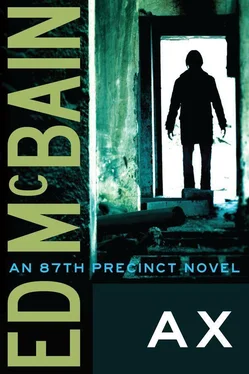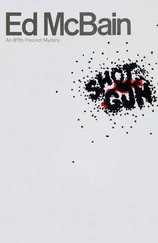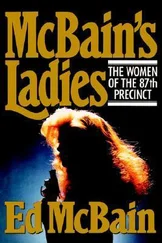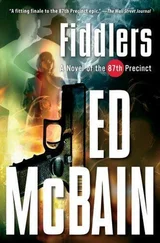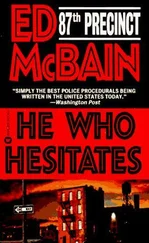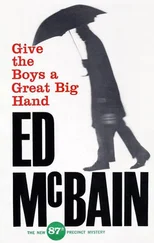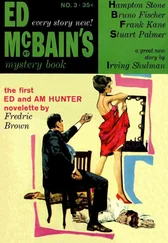“No, just under my nose,” Mark said.
“Okay. Here we go.” He pulled the blanket higher.
“Just under my nose, too, Daddy,” April said.
He tugged on her blanket, kissed her again, put out the light, and went into the kitchen.
“What rhymes with April?” he asked Fanny.
“Don’t bother me with your riddles,” Fanny said. “Go sit down before your soup gets cold.”
During dinner, he told Teddy about the old man they had found in the basement. She watched his mouth as he spoke, stopping him every so often to ask a question, but for the most part simply watching him intently and trying to understand everything he said, listening carefully for details. She knew her husband very well, and she knew that this was not the last she would hear of the old man who had been slain with an ax. She knew there were husbands who left their work in the office, and she knew that her own husband had vowed a hundred times or more never to bring the sometimes filthy details of police work into his home. But each time his resolve would last a week, ten days, two weeks at the most, and suddenly he would begin talking about a particularly disturbing case, and always she would listen carefully. She listened because he was her husband, and she was his wife, and if he’d happened to be in the peanut industry, she would have listened to facts and figures about peanut oil and peanut butter.
Her husband’s line of work was criminal detection.
So she listened to him as he talked about an eighty-six-year-old man who had been found in the basement of a building with an ax in his head, and she listened as he told her of all the mother-son combinations he had met that day, listened as he told her of the demented Mrs. Lasser and her son who never left the house, told her of the positive identification from a police photograph, told her of the way Mrs. Lasser had begun laughing hysterically when she looked at the glossy identification photo of her dead husband, the ax still protruding from his skull, told her what Anthony Lasser had said about his father’s friends, a group of Spanish-American War veterans who called themselves The Happy Kids. She listened with her eyes and her entire face. She asked questions with her silent lips and her rapidly moving hands.
Later, when the meal was finished, and the dishes were done, and the twins were sound asleep, and Fanny had left the house for the night, they went into their bedroom and stopped talking.
January 4 was a Saturday, but police departments do not know Saturday from Tuesday, nor for that matter Christmas from St. Swithin’s Day. Carella met Hawes at 8:30 in the morning, and together they drove again to New Essex where they hoped to talk to some of the members of the late George Nelson Lasser’s club, the group of Spanish-American War veterans who were known as The Happy Kids. The day was as bleak and foreboding as the day before had been. Carella was driving one of the squad’s battered sedans, and Hawes seemed only half-awake on the seat beside him.
“Get in late last night?” Carella asked.
“No, not too late. We went to a movie.”
“What’d you see?”
“The Locusts,” Hawes said.
“Oh, yeah? How was it?”
“Well, it made me kind of itchy,” Hawes said. “It’s about these locusts that start an uprising, you know. Against the human race.”
“Why do they do that?”
“Well, that’s a good question,” Hawes said. “In fact, the hero is asked that question about six or seven times in the picture, but all he can say each time is ‘I wish I knew.’ I’ll tell you the truth, Steve, I wish I knew, too. All those locusts crawling all over everybody without any reason. It was very scary.”
“They just decide to kill humans, is that it?”
“Yeah. Well, there’s a story besides. I mean, it isn’t all about locusts killing people. There’s a love story, too. Sort of.”
“What was the love story about?”
“Well, it’s sort of about this girl who gives the hero two crickets in a cage. For his hearth, you see. You know, crickets on the hearth.”
“Yeah,” Carella said.
“Yeah, they make a pun about it, in fact. Instead of ‘hearth,’ they say ‘heart.’ Crickets on the heart.”
“That’s pretty funny,” Carella said.
“Yeah,” Hawes said. “So she follows this guy all the way to Kweichow Province—”
“To where?”
“Kweichow Province. That’s in Communist China.”
“Oh, I see.”
“Yeah, she follows him there with the crickets in the cage, which he wanted as a gift for his aging Chinese nanny. She’s very old—she’s played by this woman who usually plays old Russian ladies, I forget her name. Anyway, that’s why he wants these crickets—it’s a little complicated.”
“Yeah,” Carella said.
“Christine thought it was the crickets who were the ringleaders.”
“Of the locusts?”
“Yeah.”
“Maybe so,” Carella said.
“You think so? How could crickets communicate with locusts?”
“I’m not sure. How do they communicate with each other?”
“They rub their front legs together, I think.”
“Maybe it’s the same with locusts.”
“I don’t think the crickets had anything to do with it,” Hawes said. “I think they were just a plot device. To get her to China.”
“Why’d they have to get her to China?”
“Well, hell, that’s where all the locusts are, Steve. Also, it gave them a chance to ring in a very pretty Chinese girl—what’s her name? You know her, she’s in all the things where they need a Chinese girl. She turns out to be an old girlfriend of the hero’s. She’s teaching in a Catholic mission which the locusts attack near the end of the picture. They eat the priest.”
“What?”
“Yeah,” Hawes said.
“That sounds like some picture.”
“Yeah, it was. They didn’t show him being eaten, of course. But the locusts were all over him, chewing.”
“Yeah,” Carella said.
“Yeah. They had some nice close-ups.”
“Who was the girl?”
“Some new girl, I forget her name.”
“And the hero?”
“Oh, he’s been around on television. I forget his name, too.” Hawes hesitated. “Actually, the locusts were the stars of the picture.”
“Yeah,” Carella said.
“Yeah. They had one scene where there must have been eight million locusts hopping all over everybody. I wonder how they got that scene.”
“There probably was a locust trainer,” Carella said.
“Oh, sure.”
“I saw a picture called The Ants once,” Carella said.
“How was it?”
“Pretty good. It sounds a little like The Locusts, though there wasn’t the girl bringing any crickets in a cage.”
“No, huh?”
“No. There was a girl, but she was a newspaper reporter investigating this nuclear reactor that blows up out in the country someplace. That’s what makes the ants get so big.”
“Oh, they were bigger than normal ants, you mean?”
“Sure.”
“Oh, well these locusts were their normal size. I mean, there wasn’t any funny stuff with nuclear reactors or anything like that.”
“No, these were big ants,” Carella said.
“The Ants, huh? That was the name of the picture?”
“Yeah, The Ants.”
“This one was called The Locusts,” Hawes said.
“The Locusts.”
“Yeah.”
They drove in silence into the heart of town. They had been told the day before that The Happy Kids met in a vacant store on East Bond—Lasser could not remember the address. They searched the street now for the store, which they had also been told was unmarked. They found what seemed to be an empty store in the middle of the 300 block, curtained across its door and its wide plateglass windows. Carella parked the car across the street, pulled down the sun visor to which was affixed a handlettered sign advising the New Essex police that this antiquated heap was driven by a city detective on a duty call, and then joined Hawes who came around the car and fell into step beside him.
Читать дальше
